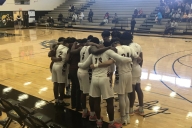You have /5 articles left.
Sign up for a free account or log in.
The National Collegiate Athletic Association’s top conferences voted last week to loosen rules restricting how Division I baseball players and men’s basketball players can interact with professional sports teams. The new policies, approved at the association’s annual meeting in San Antonio, were largely met with praise from athletes and sports leaders at the convention, who called the changes overdue.
“People might need to leave school for a while to give their athletic ambitions an opportunity to flourish, whether that’s participating in the Olympics or trying out for the [National Basketball Association]," said Harris Pastides, president of the University of South Carolina and chair of the NCAA Division I Board of Directors. “I think they deserve that opportunity, but they deserve to come back to school if they don’t make it. We must allow that flirtation with the professional world without saying, ‘You’re gone and you can’t come back.’”
Most college athletes vastly overestimate their chances of playing their sport professionally, and that’s especially true for players in Division I, the NCAA’s most competitive level. According to recent data from the association’s GOALS study, nearly three-quarters of Division I men’s basketball players think they are likely to become a professional athlete, as do nearly half of Division I baseball players.
Less than 9 percent of all NCAA baseball players will be drafted by a professional baseball team, and 1.2 percent of all college basketball players will be drafted by a National Basketball Association team. The chances are higher if players set their sights lower, but the numbers still point to a significant disconnect. About 11 percent of all NCAA men’s basketball players will play professionally, including on international teams.
In his state of the association address at last week’s meeting, Mark Emmert, president of the NCAA, said coaches and administrators have the opportunity to help those who can succeed professionally, but also the obligation to help temper expectations for other students. Emmert said last week's rule changes were a “terrific” way to do that, as they allow athletes to “develop an objective reality of what their prospects” are without losing their college eligibility.
“What keeps me up at night is that we all know there’s a huge number of our student-athletes who have grossly unrealistic expectations of playing professional sports,” he said. “There’s a lot who are going to have that dream taken away, and they are going to have to deal with reality.”
The new basketball rule was approved by the NCAA’s Division I Council last Wednesday. The change allows athletes to enter the draft multiple times and pushes back the date by which an athlete must remove his name from the National Basketball Association draft in order to remain eligible to play on a college team. Previously, the NCAA’s deadline did not allow athletes to participate in the NBA draft combine, a multiday showcase for college players.
Division I basketball players can now participate in the combine, as well as one tryout per NBA team. The events are by invitation only.
“I am of the belief that a student-athlete who does not receive an invite to the draft or an invite to work out with a team will make the smart decision to return to college to continue to grow as a player,” said Cody McDavis, a member of the Division I Men’s Basketball Oversight Committee and a recent graduate of the University of Northern Colorado. “However, should they receive an invite, they will have an opportunity to compete against draft-potential competition and receive feedback on their performance. Either way, they have an opportunity to make an educated decision that is best for them and their family.”
Division I baseball players had similar praise for the rule changes in their sport. During a legislative session on Friday, the members of the five wealthiest Division I leagues -- the Atlantic Coast, Big Ten, Big 12, Pac-12 and Southeastern Conferences -- voted to allow high school baseball players to hire an agent without losing their NCAA eligibility. Previously, if a high school player hired an agent, the NCAA considered him to no longer be an amateur athlete and therefore ineligible.
Unlike basketball players, who cannot enter the NBA draft until they are 19 and one year removed from high school, baseball players can enter the Major League Baseball draft immediately after high school graduation. If they choose to go to college first, however, they have to wait until their junior year before trying again.
“You’re dealing with high school students who are approached by professional baseball scouts, and a life-changing amount of money can be thrown your way,” Anthony Lyons, an outfielder at Texas Tech University, said. “In this situation, it’s very important for student-athletes in high school and their families to feel comfortable, to have an agent or adviser or lawyer to help them out. I believe this proposal will help not only preserve eligibility for student-athletes all across the nation, but also help them smoothly transition into their college athletic experience.”
While NCAA officials and athletes cited the small percentage of players who become professional athletes as reason for creating the new rules, Ron Katz, a sports lawyer and chair emeritus of the Institute of Sports Law and Ethics at Santa Clara University, argues that the changes endanger the association's theoretical model of amateurism. In a recent analysis of the new basketball policy, Katz said that the rule "emphasizes the professional few" over the vast majority of college athletes.
Restricted to Division I and the NBA, the new rule does not cover players interested in playing in the Women's National Basketball Association or male athletes wishing to play internationally. Of the 18,320 NCAA athletes who played men's basketball in 2013, only 47 were drafted by NBA teams.
"This focus on the top few tenths of 1 percent of players does not even amount to the tail wagging the dog," Katz wrote. "It is a flea on the tail wagging the dog."








